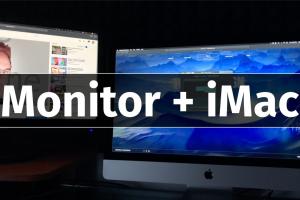Maximizing Your iMac: A Comprehensive Guide to Using Your iMac as an External Monitor

-
Quick Links:
- 1. Introduction
- 2. What is Target Display Mode?
- 3. Requirements for Using Target Display Mode
- 4. Setting Up Target Display Mode
- 5. Using AirPlay as an Alternative
- 6. Requirements for Using AirPlay
- 7. Setting Up AirPlay
- 8. Pros and Cons of Using iMac as an External Monitor
- 9. Case Study: Real-World Usage
- 10. Conclusion
- 11. FAQs
1. Introduction
With the increasing demand for multi-monitor setups, many users wonder how to utilize their existing devices more efficiently. One innovative solution is using an iMac as an external monitor. This can enhance productivity by providing additional screen real estate. In this guide, we will explore two primary methods to achieve this: Target Display Mode and AirPlay.
2. What is Target Display Mode?
Target Display Mode is a feature that allows certain iMac models to act as an external display for another Mac. This is particularly useful for users who want to extend their desktop workspace using their existing iMac.
3. Requirements for Using Target Display Mode
- Compatible iMac model (2011-2014 models with Thunderbolt or Mini DisplayPort).
- A compatible Mac that supports Target Display Mode.
- Thunderbolt or Mini DisplayPort cable.
4. Setting Up Target Display Mode
Follow these steps to set up Target Display Mode:
- Ensure both Macs are powered on.
- Connect the two Macs using the Thunderbolt or Mini DisplayPort cable.
- Press Command (⌘) + F2 on the iMac keyboard to activate Target Display Mode.
- To exit Target Display Mode, press Command (⌘) + F2 again.
5. Using AirPlay as an Alternative
If your iMac model does not support Target Display Mode, you can use AirPlay to mirror or extend your display wirelessly. This method provides greater flexibility and convenience.
6. Requirements for Using AirPlay
- An iMac running macOS Monterey or later.
- A compatible Mac that supports AirPlay.
- Both devices should be on the same Wi-Fi network.
7. Setting Up AirPlay
To set up AirPlay, follow these steps:
- On your Mac, click the AirPlay icon in the menu bar.
- Select your iMac from the list of available devices.
- Choose whether to mirror your display or use it as a separate display.
- Adjust display settings as needed in System Preferences.
8. Pros and Cons of Using iMac as an External Monitor
Pros
- Cost-effective solution utilizing existing hardware.
- Enhanced productivity with additional screen space.
- Wireless connection option with AirPlay.
Cons
- Not all iMac models support Target Display Mode.
- AirPlay may introduce latency.
- Requires compatible cables for wired setup.
9. Case Study: Real-World Usage
Consider a graphic designer working on multiple projects simultaneously. By using an iMac as an external monitor, they can have their design software open on one screen while using the other for reference materials. This setup greatly enhances their workflow and efficiency.
10. Conclusion
Using an iMac as an external monitor can significantly boost your productivity. Whether you choose to use Target Display Mode or AirPlay, both methods offer unique advantages. Assess your needs and capabilities to determine which setup works best for you.
11. FAQs
1. Can any iMac model be used as an external monitor?
No, only specific models from 2011-2014 support Target Display Mode.
2. What cable do I need for Target Display Mode?
You will need a Thunderbolt or Mini DisplayPort cable.
3. Can I use AirPlay with older Mac models?
AirPlay requires a Mac running macOS Monterey or later.
4. Is there a lag when using AirPlay?
Yes, AirPlay may introduce some latency compared to a wired connection.
5. How do I exit Target Display Mode?
Press Command (⌘) + F2 on the iMac keyboard.
6. What if my iMac doesn't support Target Display Mode?
You can use AirPlay as an alternative for mirroring or extending your display.
7. Can I use my iMac as a monitor for a Windows PC?
No, Target Display Mode only works with compatible Macs.
8. Does using an iMac as a monitor affect performance?
Performance may vary based on the connection method, but many users report minimal impact.
9. Can I use my iMac for gaming as an external monitor?
Using AirPlay may introduce latency, which is less ideal for gaming compared to a direct cable connection.
10. What is the maximum resolution supported in Target Display Mode?
The maximum resolution supported is typically 2560x1440, depending on the iMac model.
For more information about using your iMac as an external monitor, check out these resources:
- Apple Support: Target Display Mode
- MacWorld: Using iMac as External Display
- Reddit: How to Use Your iMac as an External Display
Random Reads
- How to network
- How to obtain netherite in minecraft
- How to organize your office
- How to organize your wardrobe
- How to panel walls with plywood
- How to partition a thumb drive
- Mastering vuze vpn socks proxy setup
- How to stucco a house
- How to stream nintendo switch to discord
- Limit social media internet use